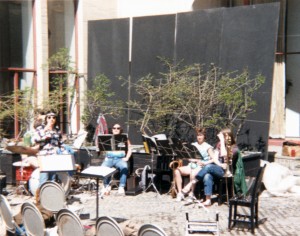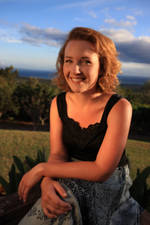Herb Pomeroy, director of jazz bands at MIT from 1963 to 1985, was known for his performance and teaching of the music of Duke Ellington. But in his early twenties, he preferred other bands more, like Count Basie and Woody Herman. There’s a great three and a half minutes in the first of his three interviews in the Music at MIT Oral History Project when Herb recalls first discovering the greatness of Duke Ellington’s music. The interview was conducted by Forrest Larson on December 14, 1999 in the MIT Lewis Music Library. Fred Harris, the current MIT jazz director, was also present.
Herb: I had no idea what Duke Ellington was all about at this point. I dismissed Ellington. I had Count Basie records, Stan Kenton records – God help me. The furthest thing in the world from jazz: Caucasian Wagnerian crap, OK, and you can print that if you want! And other bands, Woody Herman’s band, Dizzy Gillespie’s band. Let’s say those three: Basie, Herman, and Gillespie. All of which were very valid, but none of which that had the profundity of Ellington – and I didn’t know this.
Basie could swing magnificently. Dizzy’s band, every time you heard it all these new creative bebop licks and harmonies and arrangements. Woody’s band, sort of a combination of the two.
And I can remember the instance that a light went off in my head. I knew that Ellington – by the time I got to be about 21 or 22, I knew that it was over my head – something there. Too many people who I respect say “listen to this.” And I went to hear a battle of bands with Ellington and Basie down in Rhode Island. There’s a ballroom just outside of Providence called Pawtuxet on the Rhodes – I think it still exists. But back in the ballroom days, 30s, 40s, and 50s, it was big.
I think I went primarily to hear Basie’s band. And on this night, all of a sudden, I was 23 at the time, something went off in my head. “Oh – there’s something more here than there is here.” Basie, I was loving and enjoying it for the excitement, the swing, the fire, and all that, the rhythm section. But then I started to see. And that for me was kind of one of these changes, like from the swing period to the be-bop period change that I went through in the mid-40s.
Fred: I’m sorry, can you recall what it might have been – orchestration, the saxophone section, I mean… ?
Herb: To say now – now let’s see, what was that? That was 46 years ago – to say now I don’t think would be an honest memory of what did happen in that very moment. It would be what I’ve come to know since then, and I started to talk about that. I want to say it had to do with that coming out of the Ellington band was the sum total of 15 or 16 human beings, each being themselves. But I came to know that later. So I’d like to think that I reacted that way then. I probably was not consciously reacting that way.
You know, I refer to in my teaching that most of the other bands were sort of push-button bands. The leader said, “Do this, and do it to this level of competency, and you’ll get a week’s pay.” And that’s an awful, terrible way of simplifying it. With Duke’s band he just says, “OK, play.”
Forrest: Yeah, they’re all soloists.
Herb: Exactly. Even within the ensemble they were improvising – not as far as the pitches, but their feeling, their sound. I mean, with Ellington, within the sax section, there’s not five saxophones trying to blend with the lead player. It’s five individuals totally being themselves as far as expression. To the point that, by certain standards of accurate section or the entrance playing, it was bad.
The sum total of five people is so much greater than the sum total of five
saxophonists. And I don’t think I realized that. I think that just
something – I was age 23, I was beginning to open up to there’s more to what my previous eight years of semi-professionalism had been leading me to.
Please note that I transcribed this interview excerpt. Any errors are mine, not the MIT Lewis Music Library’s. The library is working on officially transcribing the interviews. Hopefully the first transcripts will be available later this year.

 The MIT Libraries News blog had a
The MIT Libraries News blog had a  Last night we attended our first concert at the
Last night we attended our first concert at the